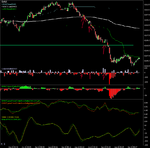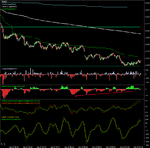DionysusToast
Legendary member
- Messages
- 5,965
- Likes
- 1,501
That coupled with the fact that DT was maybe a bit too keen to post his earnings and he made reference to learning a "paid-for" system in 6 hours from someone on T2W. So why would this system work when no one else's would?
It is interesting here that no-one ever posts actual results, everyone claims to be profitable and when someone does post results, they MUST have a motive.
6 hours of training was all it took, the information is not in any trading book that I have seen. The thing is - it's not mechanical, which is something most people look for in TA.
You know how it goes. One of the other things mainstream TA literature/websites offers is a 'mechanical' probablistic approach that ABSOLVES the trader of making any decisions. People want a ruleset so when A, B and C line up, they make a trade and let probability do the rest.
The turning point for my swing trading (in fact, all of my trading) was when I let this go. I decided that there was not going to be a mechanical ruleset I could use, that my own disctretion had to play a part and that ultimately I had to take full responsibility for my winners and losers and not mark it down to probability. Of course, we all have losing trades, it is the nature of the game.
TA for newbies is all about taking an easy route to success. It is about bypassing discretion and handing all responsibility to probability. This clearly does not work.
Now - when I had this 6 hours of training, I still had to put in a LOT of time because it's not a ruleset or system. There's a lot of discretion involved. It was not a cookie cutter formula.
It's like driving a car, someone can give you the theory but when you get in the car the first time, it seesms like there's so many things you have to pay attention to. So - after the training came a few months of getting it wrong on a daily basis until I got in the groove and all of the information started to click. It is not a particularly pleasant process but worthwhile if you stick to it.
Now - I am not advising anyone to take the course, I am normally very anti-vendor, I hate scammers in this industry that suck the money from newbies. Most vendors cannot trade. I lost $3000 to a dodgy vendor who couldn't trade. I wasted a lot of time/money on books written by people that couldn't trade. I also wasted a lot of time on these sites not understanding that there was a large community of people talking a good game but not actually trading.
I have one goal here. That is to help people learn from my mistakes.
Take responsibility, understand the market you are trading, understand what forces exist that move the market (and that isn't the MACD), use TA sparingly, and concentrate on developing your discretionary skills.


